So what do you do in Athens once you have seen the Acropolis? Well, first of all there are tons of other ruins all around it, usually in very scenic locations, among pines or with beautiful vistas over the city.
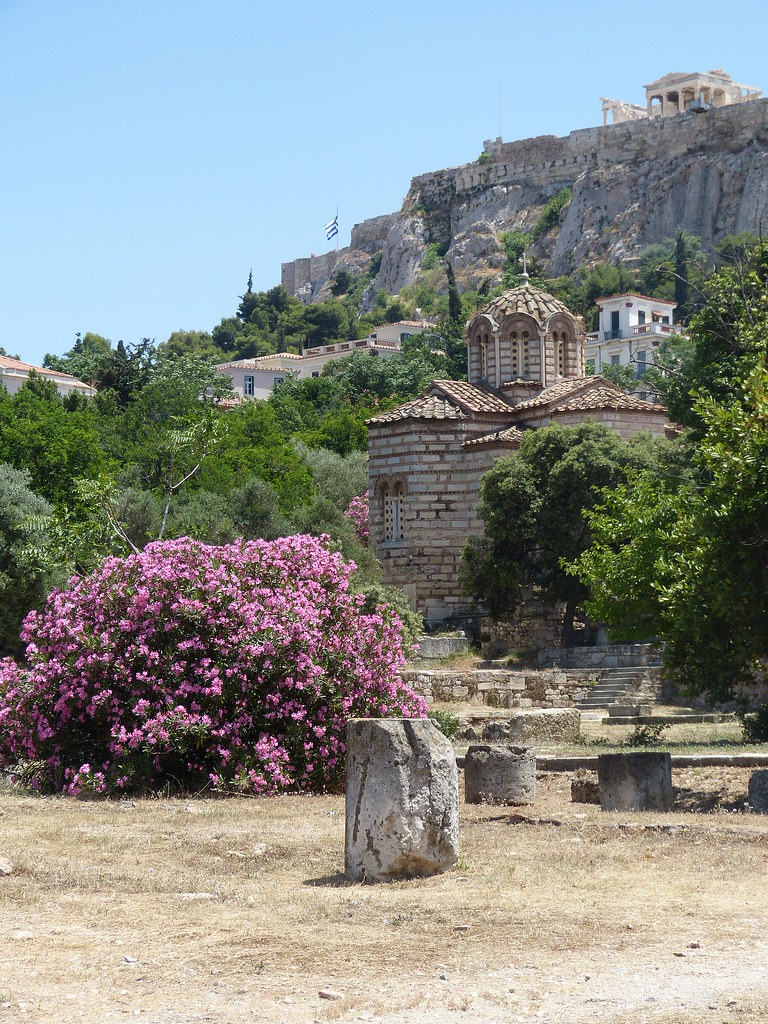 |
| View of the Acropolis from the Agora |
The Ancient agora
The agora was the centre of life in ancient Greece and it is really worth to pay a visit. The agora of Athens is located to the north-west of the Acropolis. The place was not at all crowded when I visited, and it felt unreal to think that people like Socrates and Aristotle held forth here! Don't be fooled by the church inside the agora, it's the Church of the Holy Apostles, and it was built much later, around the 10th century AD.
 |
| Ruins of statues, Ancient Agora |
The stoa of Attalos (stoas were porticos for public use in Ancient Greece) used to be full of workshops in ancient times, and it has now been completely restored. It contains the museum of the Agora and a much-needed shaded portico.
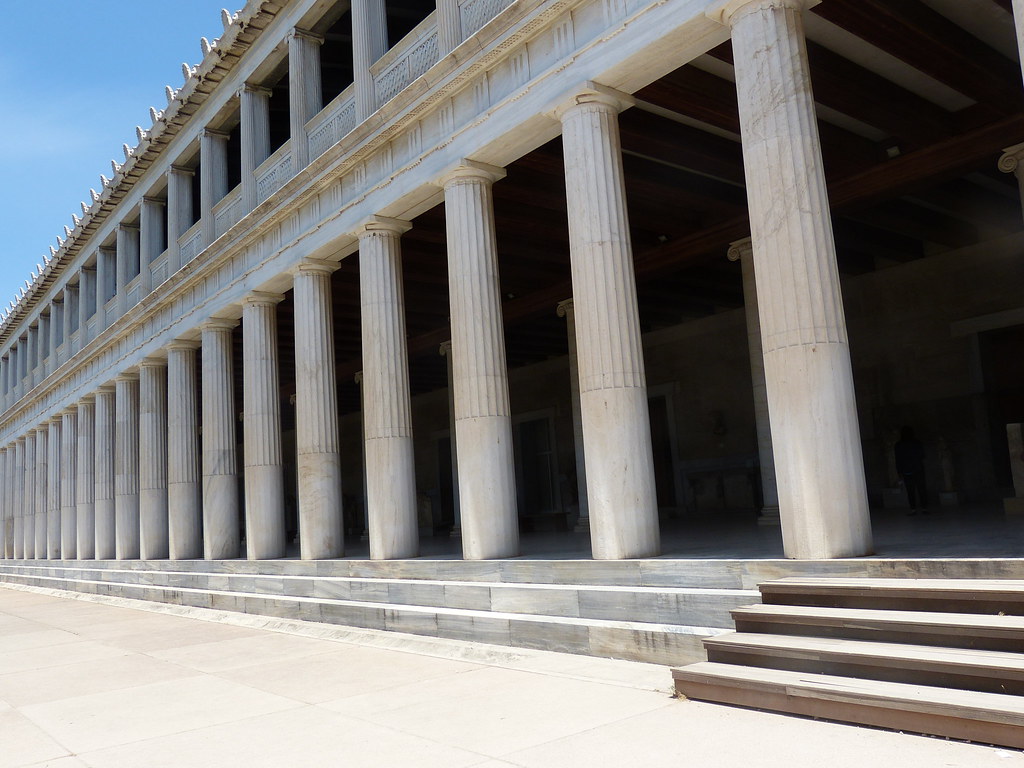 |
| Stoa of Attalos, Ancient Agora |
The temple of Hepheastus is an exceptionally well-preserved temple surrounded by green trees that will make you feel as if you still were in Ancient Greece. It was dedicated to the patron god of metal working and craftsmanship. Here they also found a slab from a gravestone with an epitaph written in Latin by Lord Byron, because in the 19th century the site was used as a place to bury non-Orthodox Christians. It's my favourite part of the Agora.
 |
| Temple of Hephaestus |
 |
| Another shot of this beautiful temple |
 |
| I can't get enough of this temple |
Filopappos hill
This is one of the pine-covered hills surrounding the Acropolis. Here you can find some interesting and quirky things, like the Prison of Socrates. Is was likely not the place where Socrates drank the hemlock, but it's good for tourists.
The 16th century church of Agios Dimitrios Loumbardiaris, hidden between the pine trees, is one of the strangest I have seen. It is tiny and mostly built with wood. From the outside it looks almost provisional or unfinished, but inside there are some interesting frescoes.
 |
| Church of Agios Dimitrios Loumbardiaris |
Aeropagus Hill
Some stair carved into the stones lead you to the top of this hill dedicated to the god Ares. There is however also a modern staircase that is much more comfortable and safe. Saint Paul gave his sermon to an unknown god from this hill, and it is here that he converted the first Greek to Christianity. From here you also have magnificent views of the Acropolis.
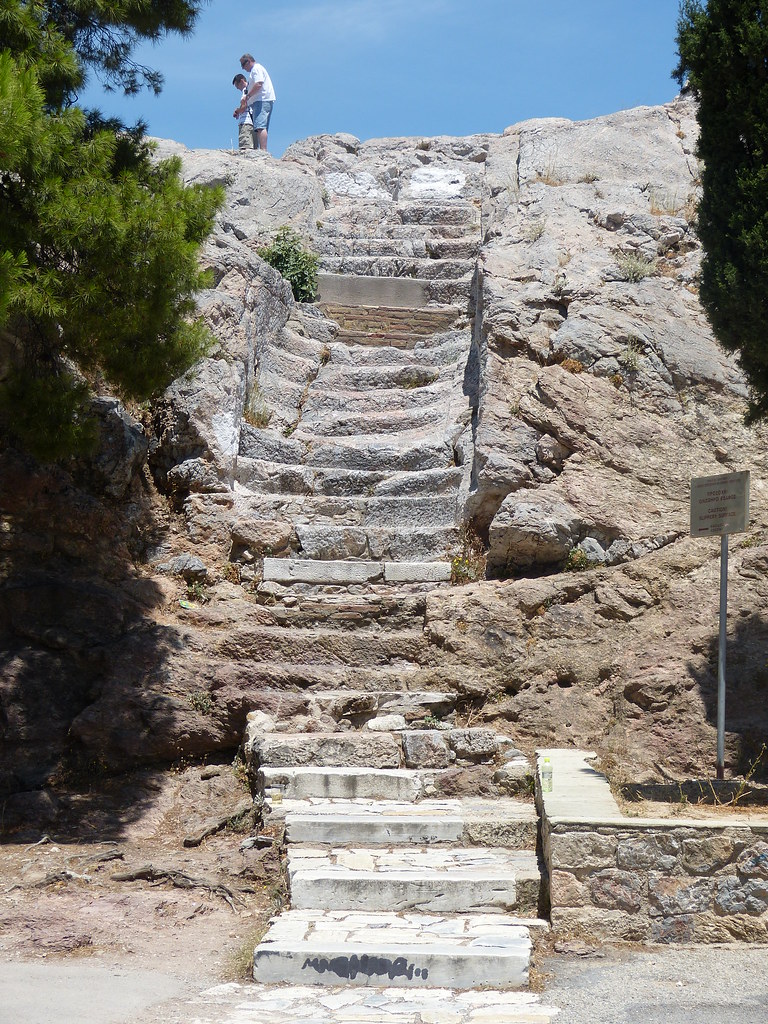 |
| Ancient stone steps leading to Aeropagus Hill |
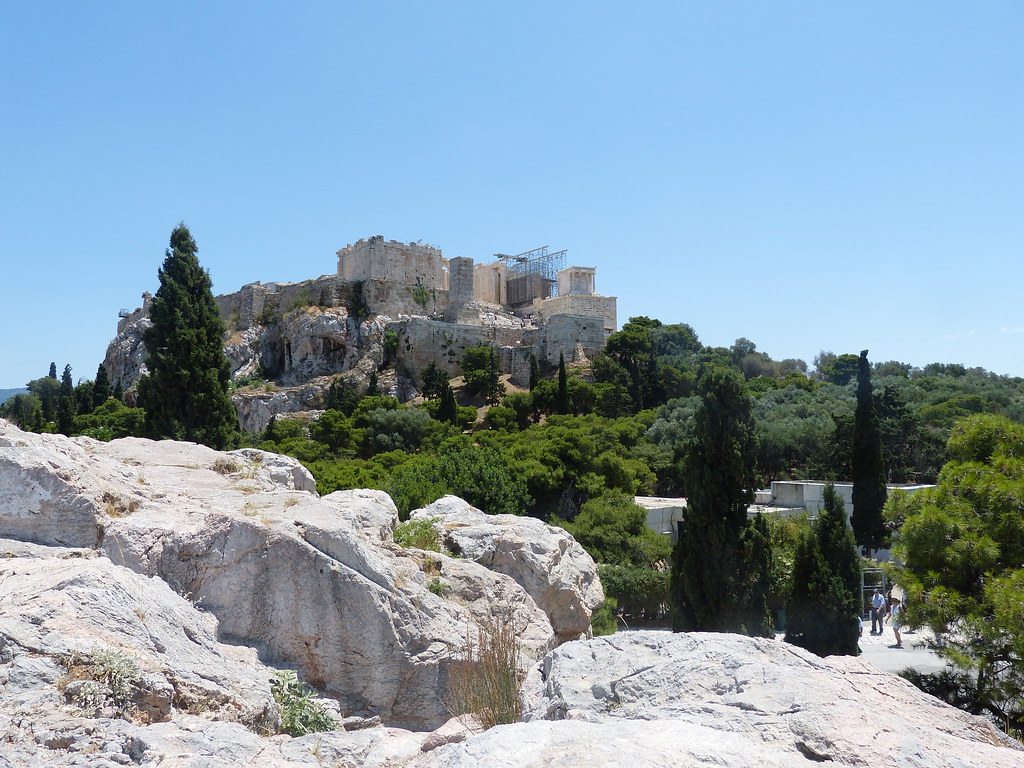 |
| View from the Hill |
The Theatre of Herodes Atticus is an ancient theatre dating back to the Roman period, and it is still used for performances. More interesting, in my opinion, is the theatre of Dionysus, the place where Greek tragedy was born! You can walk among the stone steps and sit on the benches, imagining that you are in Ancient Greece, watching a play by Sophocles or Euripides. While I was in Crete, my guide to the Knossos Palace had anticipated that I would be seeing the place where theatre was basically born. What a thrill!
Acropolis Museums and National Archaeological Museum
The Acropolis Museum and the Archaeological Museum are also really worth visiting, especially if you are into classical art. The first is brand new, big and modern, with plenty of space for the famous frieze of the Parthenon at the British Museum, while the second is located in a completely different part of the city from the other ruins. To get there you can take the underground and get off at Viktoria. I particularly liked the korai, statues of maidens. This one is holding a fig if I remember well.
 |
| Statue of a kore, National Archaeological Museum |
Athens: the bad side
So, was Athens as bad as they say it is? Well, it has its good and bad sides. What I have written so far is the good side, and it is a marvellous, not a good side. And now for the bad side...
For a start, while I was trying to make my way towards the hostel, at 2 in the morning, with a dodgy map of Athens, I found myself in what was supposedly the street where my hostel was located, very close to Monastiraki. Only the place was a bit run down: shutters filled with graffiti, broken pavements, no street lights, and nobody around. It didn't give a good first impression of Athens, I'm afraid. The hostel was very good, with new furniture and excellent security, very clean and with an additional view of the Acropolis from the terrace where they also serve food. The street where it was located, though, even during the day was a major let down. There was only a snack bar, and the shutters remained close during the day.
I didn't find the city unsafe, though, although different people can have different perceptions of that. I made friends with two people in the hostel, an Indian guy and a Brazilian girl. While the Indian guy had moments when he saw corners of India in Athens, in the run-down courtyards for example, and laughed about it, the Brazilian girl thought "it looks like Brazil, it must be unsafe". As for me, I had moments where I felt at home, in the "sweet crappiness" of my country.
For the rest, I noticed that you have to look harder than in other European capitals for quality sightseeing if you become bored with ruins. Plaka, an area that all the guidebooks mentioned as vibrant, wasn't much different from what I had seen in Crete, and it looked less authentic. Unfortunately, what they say about Athens is true: at soon as you venture outside of the historical centre where the main ruins are, the city turns into a nightmare of traffic and smog, uninspiring and noisy. Monastiraki flea market wasn't much of a flea market, but rather a street with the kind of shops you can find everywhere else in Greece. I guess it was the wrong day of the week. Moreover, the Roman Forum was always closed when I passed, but I could see the ruins through the gates. The octagonal Tower of the Winds was used as a sundial, a water clock and a wind vane. In this area of Athens there were many stray dogs, but they are looked after by the local people, so they don't look scruffy at all.
I didn't find the city unsafe, though, although different people can have different perceptions of that. I made friends with two people in the hostel, an Indian guy and a Brazilian girl. While the Indian guy had moments when he saw corners of India in Athens, in the run-down courtyards for example, and laughed about it, the Brazilian girl thought "it looks like Brazil, it must be unsafe". As for me, I had moments where I felt at home, in the "sweet crappiness" of my country.
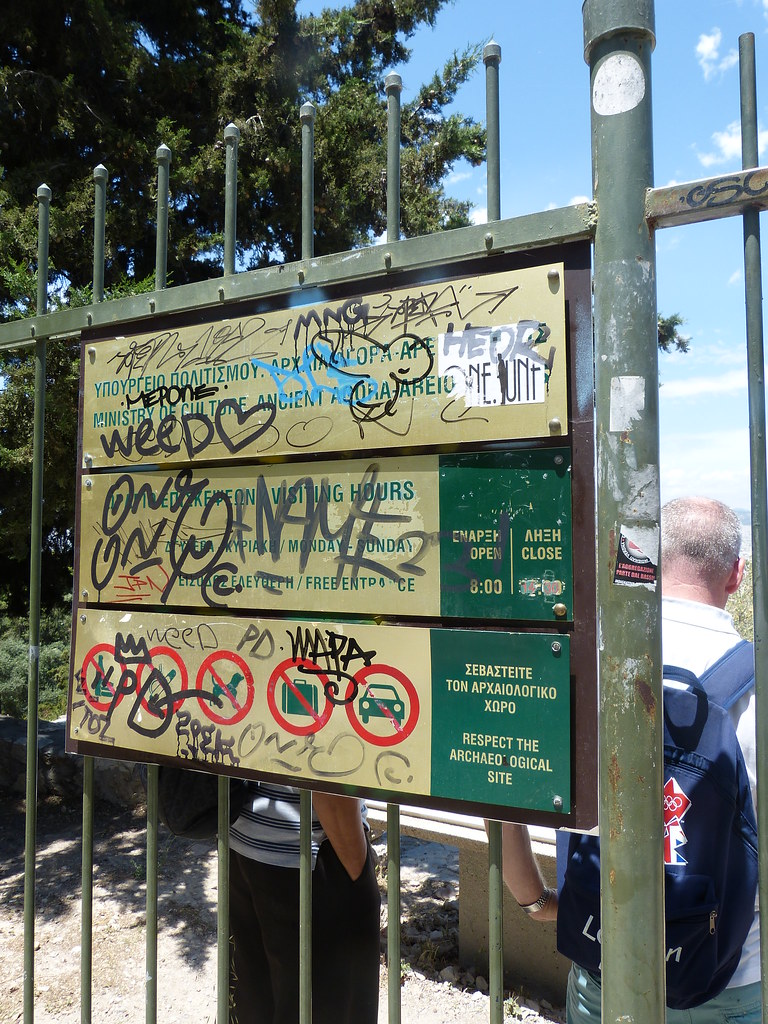 |
| This is totally Italian-style |
For the rest, I noticed that you have to look harder than in other European capitals for quality sightseeing if you become bored with ruins. Plaka, an area that all the guidebooks mentioned as vibrant, wasn't much different from what I had seen in Crete, and it looked less authentic. Unfortunately, what they say about Athens is true: at soon as you venture outside of the historical centre where the main ruins are, the city turns into a nightmare of traffic and smog, uninspiring and noisy. Monastiraki flea market wasn't much of a flea market, but rather a street with the kind of shops you can find everywhere else in Greece. I guess it was the wrong day of the week. Moreover, the Roman Forum was always closed when I passed, but I could see the ruins through the gates. The octagonal Tower of the Winds was used as a sundial, a water clock and a wind vane. In this area of Athens there were many stray dogs, but they are looked after by the local people, so they don't look scruffy at all.
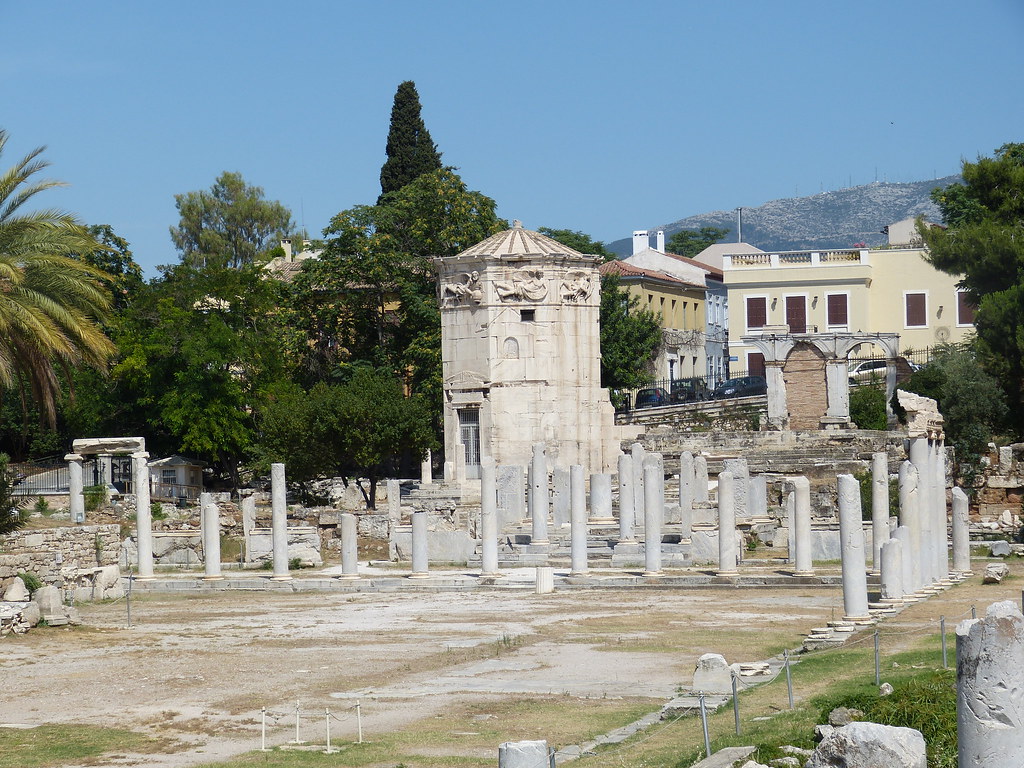 |
| The Roman Forum and the Tower of the Winds |
My last "port of call" in Athens was Plateia Syntagmatos, which means Square of the Constitution. It is where the Greek Parliament is located, and where the characteristic changing of the guard takes place. I got off at Syntagma underground station and then crossed a large trafficked road. I waited under the shade of a tree for the changing of the guard.
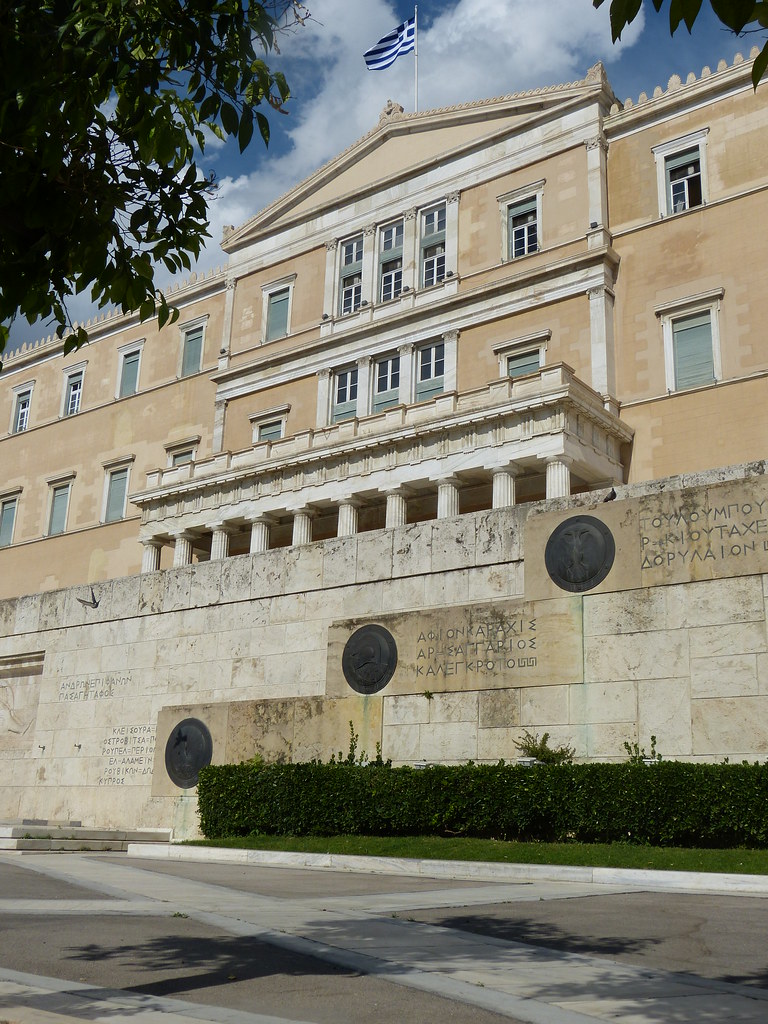 |
| The Parliament Building |
The guards, called evzones, wear pom-pom footwear and a kilt, an attire derived from the mountain-folk people who fought against the Ottoman occupation. Every hour they perform a complex "choreography" that involves coordinated movements. There were also some soldiers guarding the square. I don't know if that's because there are some protests every now and then in this place, or if they were there just to make sure that the tourists didn't bother the guards.
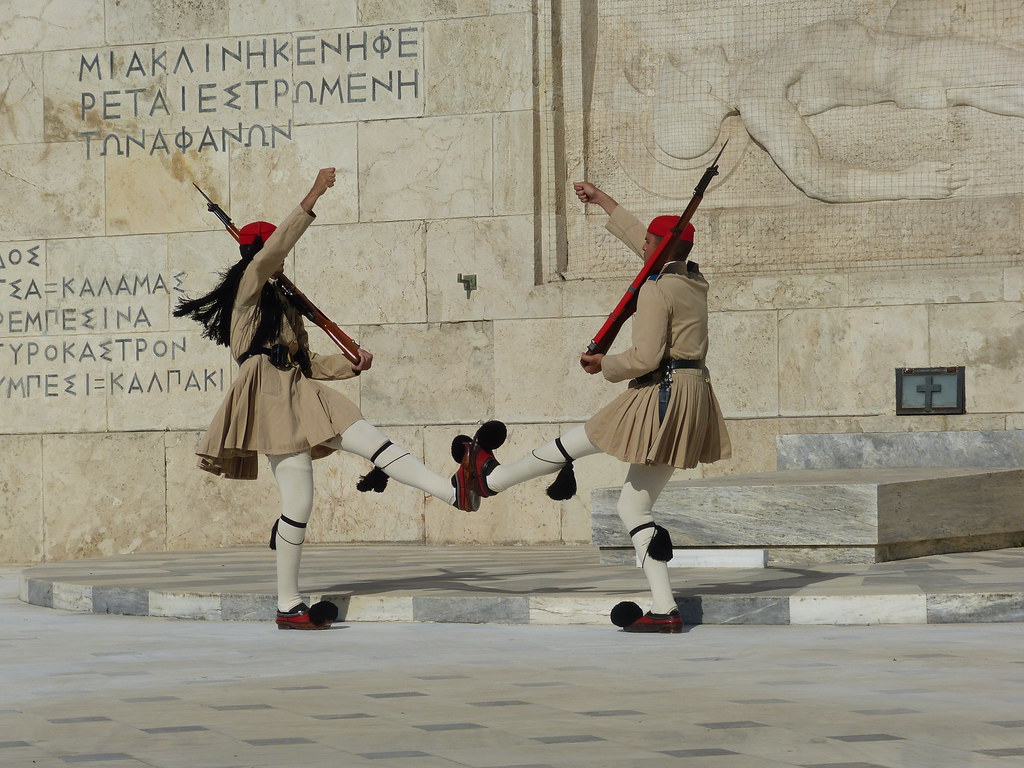 |
| Changing of the Guard |
This last thing was to show you that there aren't only ruins in Athens, even though they are certainly the most interesting thing in this city. Athens may be a bit rough around the edges, but I'm happy I visited. The good sides supersede the bad ones. Next time I'd like to explore with a Greek person, in order to understand what they make of this ancient and bitter-sweet city.
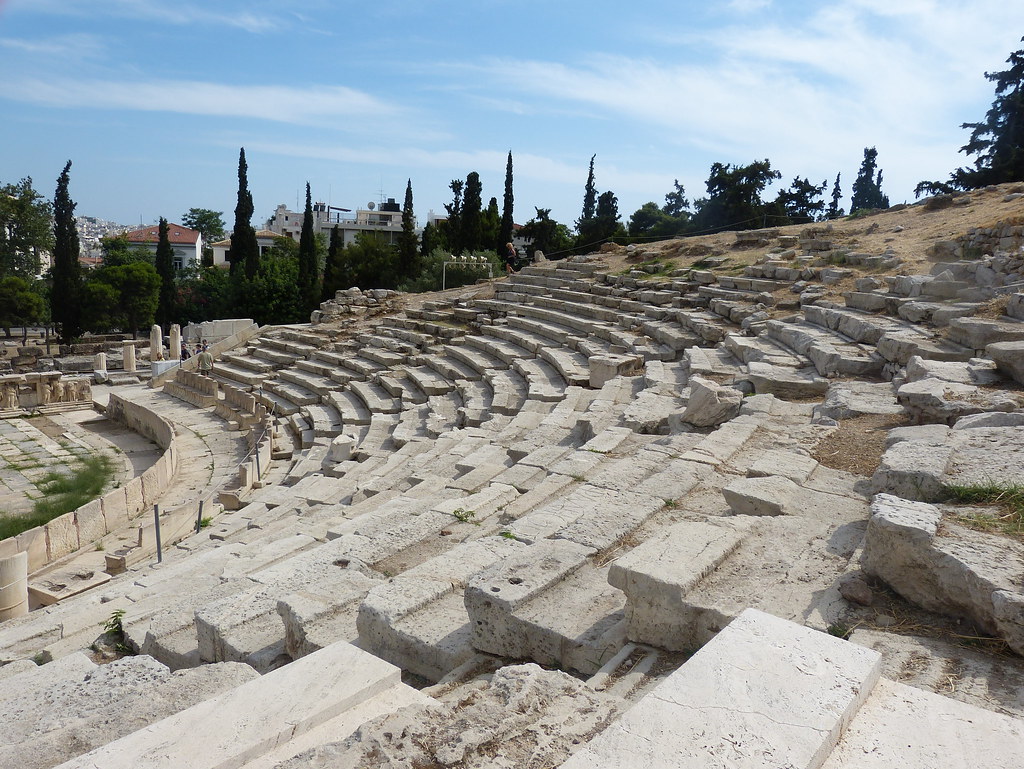
Great overview of Athens, Stefania. Hephaestus looks absolutely amazing. And architecturally, the Church of Agios looks like a building you might see in Japan.
ReplyDeleteInteresting that you think that church could be Japanese, but I understand what you mean. Perhaps it's the wide roof. When I first approached it I thought it was a bar!
DeleteI made it to Greece in August this year, but I stayed in Crete only. Never went to Athens as it was pretty far and I had only 5 days to explore Crete probably. I don't regret, but Athens is a place where I could spend hours and hours as I'm so interested in ancient history. Love the photos of Theatre of Dionysus :)
ReplyDeleteYes, it's far from Crete! I took the boat from Santorini to Athens and it was a nightmare! Anyway, if it was so hot in Athens at the beginning of June I can't imagine in August. In Crete at least there is some breeze (sometimes)!
Delete